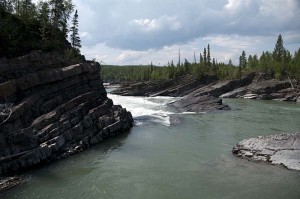We were awakened this morning earlier than we wanted by the sound of the pump squeaking next to our campsite. Unfortunately, the well doesn’t really work very well, and most people tried a few strokes, then gave up. These people were speaking French, so I really didn’t catch what they said, but they tried a few times, then gave up. It was enough to wake sus though, so we got out of bed. I saw them a few minutes later with a pail, getting water from the creek.
We drove just a few kilometers and hiked in about 500 m to some erosion pillars (hoodoos). One of them is probably the biggest we have ever seen.
We drove to Laird Hotsprings, and arrived there just before lunch. My original plan had been to stay there for the day, but it was far too early to stop, so instead we hiked in to the pools, and took some pictures. After getting our lunch from the refrigerator we drove on.
We pulled in to Smith River falls, and drove in about two km to the river. The area has all been burned last year, and there were several newly fallen trees on the road, but they had been cut through. The falls are a spectacular double drop of about 30 m, but somewhat hard to see. There is a hiking trail to the bottom, but it is incredibly steep, almost vertical, and if there was a railing there it had all burned off. So we didn’t go to the bottom.
Next we stopped at Whirlpool Rapids on the Liard river. The river is not high, but the rapids are still very rough. If the water was high there would be an enormous back eddy, where there were many logs dumped on the very sharp and jagged rocks. The rock must have a good deal of iron in it, for it is very rusty colored.
We then drove to Watson Lake. I saw a buffalo along the way. We are now at the library doing this posting, and will be camping in the area. Since Enid tore the rivet from her boot, we want to get to Whitehorse during a weekday, so we can get it fixed, so we will probably be travelling fairly fast over the next two days.

